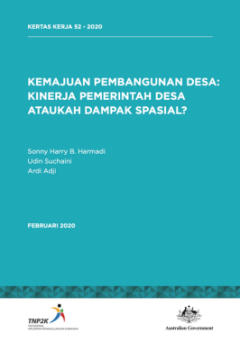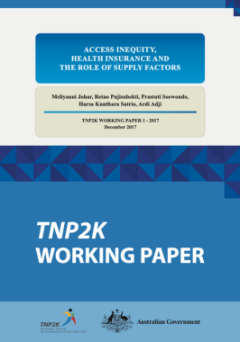Ditapis dengan

In Data We Trust? An Analysis Of Indonesian Socio-Economic Survey Data.
What if a popular data set that has generated a long stream of literature has been misunderstood and has led to misleading inferences? In this paper, we use the case of household expenditure in the Indonesian National Socio-Economic Survey data, SUSENAS, which started over 50 years ago. Appropriate use of SUSENAS for policy analysis requires an understanding that the expenditure variable in SUS…
- Edisi
- Working Paper 33
- ISBN/ISSN
- -
- Deskripsi Fisik
- PDF, 13 halaman
- Judul Seri
- Textbook dan Working Paper
- No. Panggil
- 300.72 JOH i

Indikator Pembangunan Desa di Indonesia: Ditinjau dari Ketidaksesuaian Indika…
Tujuan dari kajian ini adalah untuk menguraikan capaian Indikator Pembangunan Desa tahun 2014 dan 2018 setelah pemerintah menggelontorkan Dana Desa sebesar Rp250 triliun, sejak tahun 2015. Ada dua indikator yang berhubungan dengan pembangunan desa di Indonesia, yaitu Indeks Kesulitan Geografis (IKG) dan Indeks Pembangunan Desa (IPD). IKG digunakan sebagai dasar alokasi formula Dana Desa, sedang…
- Edisi
- Kertas Kerja 51 - 2020
- ISBN/ISSN
- -
- Deskripsi Fisik
- 33 Halaman ; 30 cm, PDF
- Judul Seri
- Working Paper
- No. Panggil
- 307.72 SON i

Kemajuan Pembangunan Desa: Kinerja Pemerintah Desa Ataukah Dampak Spasial?
Penggelontoran dana desa sebesar Rp257,2 triliun dalam 5 tahun belakangan ini (2015-2019) memiliki skema pembagian dana secara merata. Hal ini bisa dilihat dari 90% proporsi Dana Desa sepanjang tahun 2015 hingga 2017 terbagi rata (Kemenkeu, November 2017). Penelitian ini bertujuan untuk membuktikan bahwa capaian pembangunan desa bukan semata karena adanya program Dana Desa, melainkan juga atas …
- Edisi
- Kertas Kerja 52 - 2020
- ISBN/ISSN
- -
- Deskripsi Fisik
- 33 Halaman ; 30 cm, PDF
- Judul Seri
- Working Paper
- No. Panggil
- 307.72 SON k

Access Inequity, Health Insurance And The Role Of Supply Factors: Working Pap…
Given the improvement in health indicators and health facilities worldwide, inequity in access to health services is one of the most pertinent and relevant issues for health policy and public health. This paper analyses the extent of the access inequities to various health care services in Indonesia, in conjunction with its recent rapid move towards universal social health insurance (SHI). The …
- Edisi
- 32
- ISBN/ISSN
- -
- Deskripsi Fisik
- 39 halaman
- Judul Seri
- Working Paper 32 - 2017
- No. Panggil
- 368.3 MEL a

Access Inequity, Health Insurance and The Role of Supply Factors
Given the improvement in health indicators and health facilities worldwide, inequity in access to health services is one of the most pertinent and relevant issues for health policy and public health. This paper analyses the extent of the access inequities to various health care services in Indonesia, in conjunction with its recent rapid move towards universal social health insurance (SHI). The …
- Edisi
- TNP2K Working Paper 1 - 2017
- ISBN/ISSN
- -
- Deskripsi Fisik
- ii, 39 Halaman, PDF
- Judul Seri
- Working Paper
- No. Panggil
- 368.3 MEL a
 Karya Umum
Karya Umum  Filsafat
Filsafat  Agama
Agama  Ilmu-ilmu Sosial
Ilmu-ilmu Sosial  Bahasa
Bahasa  Ilmu-ilmu Murni
Ilmu-ilmu Murni  Ilmu-ilmu Terapan
Ilmu-ilmu Terapan  Kesenian, Hiburan, dan Olahraga
Kesenian, Hiburan, dan Olahraga  Kesusastraan
Kesusastraan  Geografi dan Sejarah
Geografi dan Sejarah